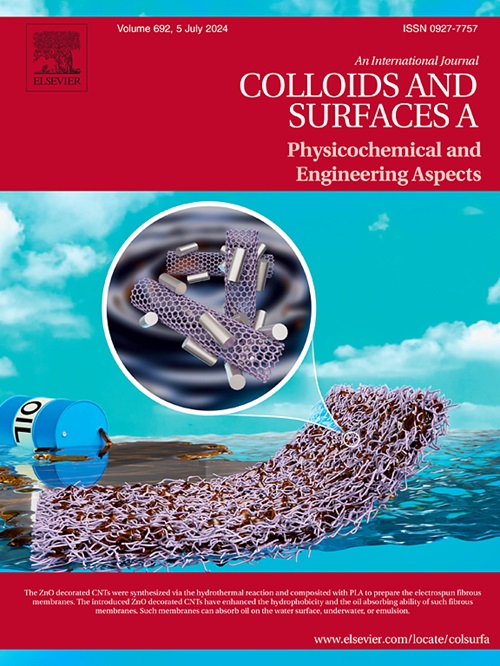Synergistic coupling of bimetallic phosphides heterojunction derived from MOF on LDH structure for enhanced electrocatalytic oxygen evolution
IF 4.9
2区 化学
Q2 CHEMISTRY, PHYSICAL
Colloids and Surfaces A: Physicochemical and Engineering Aspects
Pub Date : 2025-06-24
DOI:10.1016/j.colsurfa.2025.137582
引用次数: 0
Abstract
Rational design of catalyst architectures to minimize active site aggregation represents a critical strategy for enhancing oxygen evolution reaction (OER) efficiency. Herein, we reported a high-efficiency electrocatalyst (Fe2P-Ni2P/NF) with a multiphase heterostructure and dispersed active sites using a morphology process that combines small-sized prussian blue analog stereotypes with nano-ceramics. Benefiting from the polycrystalline heterogeneous structure and abundant active sites, the Fe2P-Ni2P/NF catalyst in 1.0 M KOH only requires overpotentials of 177 mV and 254 mV to reach current densities of 50 and 200 mA cm−2, respectively, with an exceptionally Tafel slope of 42 mV dec−1 and remarkable stability. In addition, the two-electrode system consisting of Fe2P-Ni2P/NF is able to achieve a current density of 10 mA cm−2 at 1.44 V. X-ray photoelectron spectroscopy (XPS) also confirms the formation of a dual-protective NiOOH/FeOOH layer on the phosphide surface during OER. This work establishes a novel interface engineering paradigm for designing robust electrocatalysts operable under industrial-level current densities.
MOF衍生的双金属磷化异质结在LDH结构上的协同偶联增强电催化析氧
合理设计催化剂结构以减少活性位点聚集是提高析氧反应(OER)效率的关键策略。在此,我们报道了一种高效的电催化剂(Fe2P-Ni2P/NF),具有多相异质结构和分散的活性位点,采用了将小尺寸普鲁士蓝模拟物与纳米陶瓷相结合的形貌工艺。得益于多晶非均相结构和丰富的活性位点,1.0 M KOH中Fe2P-Ni2P/NF催化剂只需要177 mV和254 mV的过电位就能分别达到50和200 mA cm−2的电流密度,Tafel斜率高达42 mV dec−1,具有良好的稳定性。此外,由Fe2P-Ni2P/NF组成的双电极体系能够在1.44 V下实现10 mA cm−2的电流密度。x射线光电子能谱(XPS)也证实了在OER过程中磷化物表面形成了双重保护的NiOOH/FeOOH层。这项工作建立了一种新的界面工程范式,用于设计可在工业水平电流密度下运行的稳健电催化剂。
本文章由计算机程序翻译,如有差异,请以英文原文为准。
求助全文
约1分钟内获得全文
求助全文
来源期刊
CiteScore
8.70
自引率
9.60%
发文量
2421
审稿时长
56 days
期刊介绍:
Colloids and Surfaces A: Physicochemical and Engineering Aspects is an international journal devoted to the science underlying applications of colloids and interfacial phenomena.
The journal aims at publishing high quality research papers featuring new materials or new insights into the role of colloid and interface science in (for example) food, energy, minerals processing, pharmaceuticals or the environment.

 求助内容:
求助内容: 应助结果提醒方式:
应助结果提醒方式:


